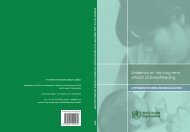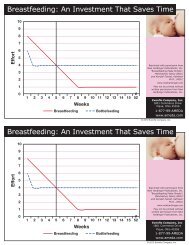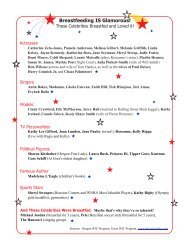Going home protocol - Breastfeeding Made Simple
Going home protocol - Breastfeeding Made Simple
Going home protocol - Breastfeeding Made Simple
- No tags were found...
Create successful ePaper yourself
Turn your PDF publications into a flip-book with our unique Google optimized e-Paper software.
supply). Specific guidance should be provided in written form to all parents regarding assessment of (a)adequacy of stool and urine output, (b) jaundice, and (c) sleep and feeding patterns.6. Every breastfeeding mother should receive instruction on techniques for expression of milk by hand orby pump so that she can maintain her milk supply and obtain milk for feeding to the infant should she andthe infant be separated or the infant be unable to feed directly from thebreast. 97. Every breastfeeding mother should be provided with names and phone numbers of individuals andmedical services that can provide advice, counseling, and health assessments related to breastfeeding on a24 hour-a-day basis, as well as on a less intensive basis. 1,5,10–128. Mothers should be provided with lists of various peer support groups (e.g., La Leche LeagueInternational) with phone numbers and addresses and encouraged to contact and consider joining one ofthese groups. 13,149. Prior to discharge, appointments should be made for (a) an office or <strong>home</strong> visit, within 2 to 3 days, by aphysician or a physician-supervised breastfeeding-trained licensed health care provider (infants dischargedbefore 48 hours of age should be seen by 2 to 4 days of age), and (b) the mother’s 6-week follow-up visit tothe obstetrician or family physician. Additional visits for the mother and infant are recommended until allclinical issues are resolved (e.g., weight gain is well established, jaundice resolving). A routine preventivecare visit should occur when the child is 2 to 4 weeks of age. 2,11,12,15,1610. If the mother is medically ready for discharge but the infant is not, every effort should be made to allowthe mother to remain in the hospital either as a continuing patient or as a “mother-in-residence” with accessto the infant for exclusive breastfeeding. Maintenance of a 24-hour rooming-in relationship with the infantis optimal during the infant’s extended stay. 17–2111. If the mother is discharged from the hospital before the infant is discharged (as in the case of a sickinfant), the mother should be encouraged to spend as much time as possible with the infant and to continueregular breastfeeding. 22 During periods when the mother is not in the hospital, she should be encouraged toexpress and store her milk, bringing it to the hospital for the infant.REFERENCES1. Kuan LW, Britto M, Decolongon J, et al: Health system factors contributing to breastfeeding success.Pediatrics 104: 28, 1999.2. The American Academy of Pediatrics, Work Group on <strong>Breastfeeding</strong>: <strong>Breastfeeding</strong> and the use ofhuman milk. Pediatrics 100:1035–1039, 1997.3. Valaitis RK, Shea E: An evaluation of breastfeeding promotion literature: Does it really promotebreastfeeding? Can J Public Health 84:24–27, 1993.4. Dungy CI, Christensen-Szalanski J, Losch M, Russell D: Effect of discharge samples on duration ofbreast-feeding. Pediatrics 90:233–237, 1992.5. Frank DA, Wirtz SJ, Sorenson JR, Heeren T: Commercial discharge packs and breast-feedingcounseling: Effects oninfant-feeding practices in a randomized trial. Pediatrics 80:845–854, 1987.6. Bergevin Y, Dougherty C, Kramer M: Do infant formula samples shorten the duration of breast-feeding?Lancet 1(8334): 1148–1151, 1983.7. Perez-Escamilla R, Pollitt E, Lonnerdal B, Dewey KG: Infant feeding policies in maternity wards andtheir effect onbreast-feeding success: An analytical overview. Am J Public Health 84:89–97, 1994.8. Aarts C, Hornell A, Kylberg E, Hofvander Y, Gebre-Medhin M: <strong>Breastfeeding</strong> patterns in relation tothumb sucking and pacifier use. Pediatrics 104:50, 1999.9. World Health Organization, United Nations Children’s Fund. Protecting, promoting and supportingbreastfeeding: The special role of maternity services (A joint WHO/UNICEF statement). Int J GynaecolObstet 31:171–183, 1990.10. Bloom K, Goldbloom RB, Robinson SC, Stevens FE: Breast versus formula feeding. Acta PaediatrScand Suppl 300:1–26, 1982.11. Chen CH: Effects of <strong>home</strong> visits and telephone contacts on breastfeeding compliance in Taiwan.Matern Child Nurs J21:82–90, 1993.12. Houston MJ, Howie PW, Cook A, McNeilly AS: Do breastfeeding mothers get the <strong>home</strong> support theyneed? Health Bull (Edinb) 39:166–172, 1981.13. Long DG, Funk-Archuleta MA, Geiger CJ, Mozar AJ, Heins JN: Peer counselor program increasesbreastfeeding rates in Utah Native American WIC population. J Hum Lact 11:279–284, 1995.








